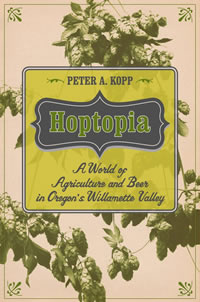 “Hoptopia” is the intriguing name of a well-researched and documented new book by Peter Kopp that tells the history of growing hops, especially in the Willamette Valley of Oregon. To set the stage, the author reviews the natural history of hops, including Humulus lupulus, a wide spread species throughout much of the north temperate world, but that is not found in our region.
“Hoptopia” is the intriguing name of a well-researched and documented new book by Peter Kopp that tells the history of growing hops, especially in the Willamette Valley of Oregon. To set the stage, the author reviews the natural history of hops, including Humulus lupulus, a wide spread species throughout much of the north temperate world, but that is not found in our region.
This all changed in the mid-19th century with the rise of the hops growing in both Oregon and Washington. Puyallup, Washington was an early center for this crop. Residents of that city are likely aware of their historic Meeker Mansion, but perhaps they do not know that its builder, Ezra Meeker, was the “Hop King” during the 1880s.
In the 20th century, prohibition threatened to destroy this industry. However, the opposite happened, because of the rising demand for the American crop in war-torn Europe. By the 1930s, hop growing was at its peak in the Willamette Valley, celebrated by the Hop Fiesta in Independence, Oregon, an event revived in this century. There were challenges, too. The extreme physical demands of harvesting hops led to strife between labor and management. Downy mildew required the breeding of resistant varieties, a process that did not have significant success until the 1970s.
Today, the center of hops growing has shifted back to Washington, as the greater Yakima Valley now is by far the largest producer of hops in the world. Meanwhile, Portland has proclaimed itself “Beervana” for its many small breweries as, according to Kopp, “…there is little question that the hop became the signature ingredient of the craft beer revolution.”
Excerpted from the Fall 2017 Arboretum Bulletin.